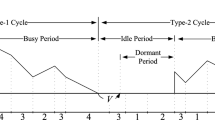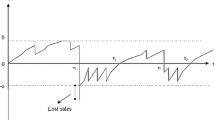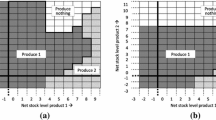Abstract
We study the performance of a reflected fluid production/inventory model operating in a stochastic environment that is modulated by a finite state continuous time Markov chain. The process alternates between ON and OFF periods. The ON period is switched to OFF when the content level reaches a predetermined level q and returns to ON when it drops to 0. The ON/OFF periods generate an alternative renewal process. Applying a matrix analytic approach, fluid flow techniques and martingales, we develop methods to obtain explicit formulas for the cost functionals (setup, holding, production and lost demand costs) in the discounted case and under the long-run average criterion. Numerical examples present the trade-off between the holding cost and the loss cost and show that the total cost appears to be a convex function of q.








Similar content being viewed by others
References
Ahn S, Badescu AL, Ramaswami V (2007) Time dependent analysis of finite buffer fluid flows and risk models with a dividend barrier. Queueing Syst 55:207–222
Asmussen S (2003) Applied probability and queues, 2nd edn. Springer, New York
Asmussen S, Kella O (2000) A multi-dimensional martingale for Markov additive process and its applications. Adv Appl Probab 32:376–393
Barron Y (2015) A fluid EOQ model with Markovian environment. J Appl Probab 52:473–489
Barron Y, Perry D, Stadje W (2014) A make-to-stock production/inventory model with MAP arrivals and phase-type demands. Ann Oper Res 1–37
Beltran JL, Krass D (2002) Dynamic lot sizing with returning items and disposals. IIE Trans 34:437–448
Berman O, Perry D (2001) Two control policies for stochastic EOQ-type models. Probab Eng Inf Sci 15:445–463
Berman O, Perry D, Stadje W (2007) Performance analysis of a fluid production/inventory model with state-dependence. Methodol Comput Appl Probab 9:465–481
Boxma O, Kaspi H, Kella O, Perry D (2005) On/off storage systems with state-dependent input, output, and switching rates. Probab Eng Inf Sci 19:1–14
Boxma OJ, Kella O, Perry D (2001) An intermittent fluid system with exponential on-times and semi-Markov input rates. Probab Eng Inf Sci 15:189–198
Boxma O, Perry D, Stadje W, Zacks S (2015) A compound Poisson EOQ model for perishable items with intermittent high and low demand periods. Working paper (in press)
Boxma O, Perry D, Zacks S (2014) A fluid EOQ model of perishable items with intermittent high and low demand rates. Math Oper Res 40:390–402
Da Silva Soares A, Latouche G (2005) Matrix-analytic methods for fluid queues with feedback control. Int J Simul Syst Sci Technol 6:4–12
De Kok AG, Tijms HC, Van Der Duyn Schouten FA (1984) Approximations for the single product production–inventory problem with compound Poisson demand and service level constraints. Adv Appl Probab 16:378–401
Fleischmann M, Kuik R, Dekker R (2002) Controlling inventories with stochastic item returns: a basic model. Eur J Oper Res 138:63–75
Germs R, Foreest NDV (2014) Optimal control of production–inventory systems with constant and compound Poisson demand. University of Groningen, Groningen
Grunow M, Günter HO, Westinner R (2007) Supply optimization for the production of raw sugar. Int J Prod Econ 110:224–239
Kella O, Perry D, Stadje W (2003) A stochastic clearing model with Brownian and a compound Poisson component. Probab Eng Inf Sci 17:1–22
Kella O, Whitt W (1992) A Storage model with a two-stage random environment. Oper Res 40:s257–s262
Kulkarni VG, Yan K (2007) A fluid model with upward jumps at the boundary. Queueing Syst 56:103–117
Latouche G, Ramaswami V (1999) Introduction to matrix analytic methods is stochastic modeling, vol 5. Society for Industrial and Applied Mathematics (SIAM), Philadelphia
Mohebbi E (2006) A production–inventory model with randomly changing environmental conditions. Eur J Oper Res 174:539–552
Perry D, Posner MJ (2002) A mountain process with state dependent input and output and a correlated dam. Oper Res Lett 30:245–251
Pinçe Ç, Gürler Ü, Berk E (2008) A continuous review replenishment–disposal policy for an inventory system with autonomous supply and fixed disposal costs. Eur J Oper Res 190:421–442
Ramaswami V (1999) Matrix analytic methods for stochastic fluid flows. In: Proceedings of the international teletraffic congress (ITC-16). Edinburgh, Elsevier
Ramaswami V (2006) Passage times in fluid models with application to risk processes. Methodol Comput Appl Probab 8:497–515
Shaharudin MR, Zailani S, Tan KC (2015) Barriers to product returns and recovery management in a developing country: investigation using multiple methods. J Clean Prod 96:220–232
Shen Y, Willems SP (2014) Modeling sourcing strategies to mitigate part obsolescence. Eur J Oper Res 246:522–533
Shi J, Katehakis MN, Melamed B (2013) Martingale methods for pricing inventory penalties under continuous replenishment and compound renewal demands. Ann Oper Res 208:593–612
Shi J, Katehakis MN, Melamed B, Xia Y (2014) Production-inventory systems with lost-sales and compound Poisson demands. Oper Res 62:1048–1063
Song Y, Lau HC (2004) A periodic-review inventory model with application to the continuous-review obsolescence problem. Eur J Oper Res 159:110–120
Song JS, Zipkin P (1993) Inventory control in a fluctuating demand environment. Oper Res 41:351–370
Taft EA (1918) The most economical production lot. Iron Age 101(18):1410–1412
Taylor HM (1968) Some models in epidemic control. Math Biosci 3:383–398
Tyler R (2004) Industry confronts equipment crunch. The Daily Telegraph (London) May 6
Vickson RG (1986) A single product cycling problem under Brownian motion demand. Manag Sci 32:1336–1345
Wu J, Chao X (2013) Optimal control of a Brownian production/inventory system with average cost criterion. Math Oper Res 39:163–189
Zhang B, Zwart B (2012) Fluid models for many-server Markovian queues in a changing environment. Oper Res Lett 40:573–577
Author information
Authors and Affiliations
Corresponding author
Ethics declarations
Conflict of interest
The authors declare that they have no conflict of interest.
Appendix
Appendix
In this “Appendix” we introduce the algorithm developed in Ramaswami (2006) for the computation of the matrix \(\Psi (\beta )\) associated with the MMFF process \((\mathcal {F}(t),\mathcal {J}(t),t\ge 0)\), as described in Sect. 3.2. Let \(\sigma (x)=\inf \{t>0,\mathcal {F}(t)=x\}\) be the first passage time to level x and define the following LST
\([\Psi (\beta )] _{ij}\) represents the LST of \(\sigma (0)\) restricted to the event that the fluid process hits level 0 at state \(j\in S_{2},\) given \(\mathcal {F}(0)=0\) and \(J(0)=i\in S_{1}.\) Ramaswami (2006, Appendix 1, p. 512) shows how to compute the matrix \(\Psi (\beta )\) and provides a good algorithm for this. The algorithm for \(\Psi (\mathfrak {\beta })\) is given as follows.
For \(\lambda >0,\) let
where U and Q define in Sect. 3.2. Choose (fixed) positive numbers \(\lambda \) and \(\delta \) such that
Define the matrices
where \(\Lambda =diag(\lambda I_{\vert S_{1}\vert },2\lambda I_{\vert S_{2}\vert })\) and \(P=P_{\lambda }.\) Consider now the following algorithm.
1.1 Algorithm
Fix \(\epsilon >0\) and set \(diff=100\);
Once we have computed \(\Psi (\beta )\), the LST matrix of other hitting times are straightforward to evaluate; we list these matrices and their sizes in Tables 3 and 4. All matrices have nice probabilistic interpretations. For more details see Ahn et al. (2007).
The following LSTs of first-passage times are needed in our analysis:
Rights and permissions
About this article
Cite this article
Barron, Y. Performance analysis of a reflected fluid production/inventory model. Math Meth Oper Res 83, 1–31 (2016). https://doi.org/10.1007/s00186-015-0517-x
Received:
Accepted:
Published:
Issue Date:
DOI: https://doi.org/10.1007/s00186-015-0517-x




